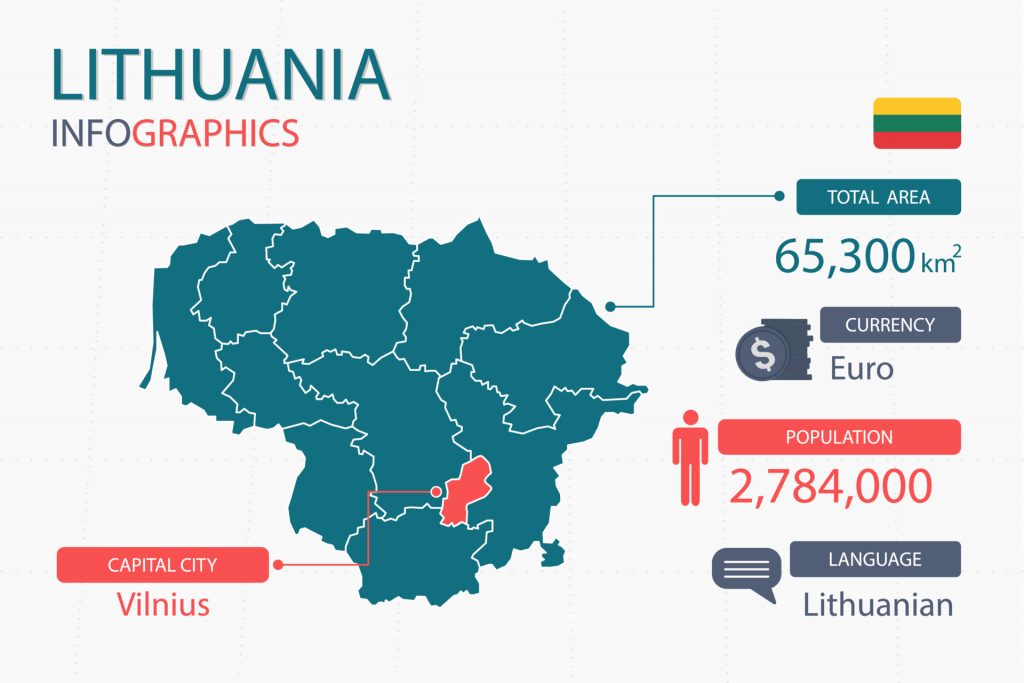The origins of the Lithuanian Language
There are about 3 million native speakers of Lithuanian. Most of the speakers reside in the country of Lithuania but some also reside abroad. In Lithuania, it is the official language. In addition, it is also an official language in the European Union as well as a recognized minority language in Poland. Moreover, it is also spoken in a variety of countries where emigrant Lithuanian communities exist, including many countries in South America (e.g., Argentina, Brazil, and Uruguay), Europe (e.g., Denmark, Germany, France, and Norway), the United States, and Australia. Thus, Lithuanian is a language that has left its mark at an international level.
Lithuanian is remarkable in how conservative it is in the sense that it retains many archaic features of the mother languages that it has evolved from, especially in terms of the overall Indo-European languages. Other languages that may be comparable are Sanskrit and perhaps Ancient Greek, even though Ancient Greek is no longer spoken. Lithuanian therefore is a valuable source of both historical and linguistic knowledge.
As Lithuanian retains so many older linguistic features that are now not as prominent, the grammar reflects such richness. As with many languages in the region, Lithuanian contains grammatical gender and grammatical case. It categorizes nouns into two genders (masculine and feminine), which is comparable to many Indo-European languages in general. A unique feature of Lithuanian is its case system, where it still has preserved a total number of seven cases, and with more archaic forms of Lithuanian, especially present in text, an additional three can be found, giving a grand total of ten cases. Such a complicated case system may make it hard for those who did not grow up with the language to learn.
Lithuanian is considered a Baltic language. The only other living language in this family is Latvian. Baltic languages that are now extinct include Old Prussian and Selonian. As Latvian is not only close linguistically but also geographically in terms of speaking community, the two share many commonalities and have influenced each others development historically, both in terms of vocabulary and grammar. In addition, Lithuanian vocabulary has also been influenced by German, Polish, Belarusian, as well as Russian and English in more recent times.

Lithuanian is written using the Latin alphabet. With the addition of the regular set of letters, it has additional ones which are formed by a combination of the regular letters and accent marks. In total, the alphabet has 32 letters. Like other languages that use the Latin alphabet, it is written from left-to-right. Lithuanian writing may be easier to learn because the letters usually correspond to one sound, unlike in English where the same letters and the same combination of letters can form different sounds.
Historically, Lithuanian, along with Latvian, is a descendent of Eastern Baltic dialects, which split from Western Baltic varieties sometime between 400 and 600 AD. Lithuanian and Latvian began to exhibit differences sometime around 800 AD. Even then, many linguists consider them dialects of a single language. Both of the languages were probably mutually intelligible with each other up until around the 16th century, when they both started to diverge and display distinct characteristics.
The earliest evidence of an authentic Lithuanian literature stems back to the beginning of the 16th century, which were a translation of Christian works. There were also printed books at this time, but these were not common as literacy was a scarce skill among speakers of Lithuanian during this period. In the 19th century, as Lithuanian was under Russian control, efforts to ban the language in education were put into place, further stifling the publication of literature. Even a ban on the use of Latin alphabet altogether, as opposed to Cyrillic, was instituted. Modern Lithuanian emerged as a standard language in the latter half of the 19th century, especially with the efforts of Jonas Jablonskis, a prominent Lithuanian linguist who is considered one of the founding fathers of the standard language. He published the first standard grammar for the language, thus codifying it and giving it more concrete conventions. This Lithuanian was based on his own dialect with a combination of characteristics taken from eastern Prussian Lithuanian dialects. These dialects preserved more archaic linguistic characteristics, including phonetic and written ones, and thus contributed to the conservatism of the language mentioned above. In 1918, Lithuanian became the official language of Lithuania. Even during the time when Lithuanian was under Soviet rule, it was used as an official language along with Russian.
Nowadays, Lithuanian is considered to have two prominent dialects. In English, they are known as Highland Lithuanian and Lowland Lithuanian. However, the Highland Lithuanian is more associated with the standard. These dialects can be attributed to both ethnic and geographical groups. Standard Lithuanian most prominently exerts influence on forms of media, literature, and administration, but other dialects have also contributed to the colloquial vocabulary.
As one of only two Baltic languages, as well as one of the most conservative languages in the world in terms of preserving archaic forms of linguistic culture, it remains a historically rich and important language. In addition, with so many Lithuanian speakers spanning the globe, it will continue to play a role in the communities in which it is used.
VEQTA can provide you with a perfect Lithuanian translator for your Lithuanian translation, English to Lithuanian translation and Lithuanian to english translation for the your targeted locale. Our translations to Lithuanian are created with your target audience in mind to meet your expectations.
If you need to translate Lithuanian – Get in touch today!
A dedicated team of Lithuanian translators who combines Experience, Specialized Subject Matter Expertise with best Translation Practices to deliver quality second to none.
Lithuanian Document Translation
Lithuanian Legal Translation
Lithuanian I.T Translation
Lithuanian Health & Fitness Translation
Lithuanian Medical Translation
Lithuanian Marketing Translation
Lithuanian Financial & Accounting Translation
Lithuanian Tourism & Travel Translation


